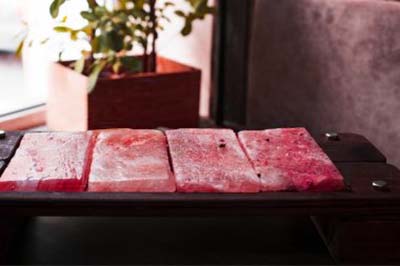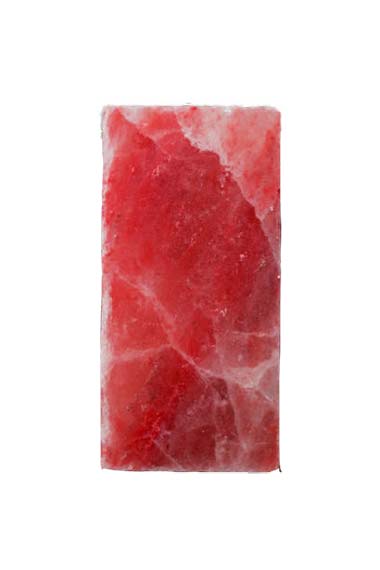Introduction of Salt Tiles and Blocks:
Salt tiles and blocks, hewn from the depths of ancient salt deposits, stand as testament to nature’s artistry and bountiful offerings. These remarkable formations, revered for their purity, rich mineral content, and striking aesthetics, have captivated civilizations for centuries. From culinary indulgences to therapeutic retreats, salt tiles and blocks have found their place in an array of applications, enriching both body and soul.
A Natural Wonder
Carved over millennia by the inexorable forces of time and geology, salt tiles and blocks emerge as crystalline treasures from beneath the earth’s surface. Sourced from regions as diverse as the Himalayas, Iran, and Poland, these formations bear the imprint of their geological origins, imbuing them with a unique blend of minerals and hues.
Versatile Applications
Salt tiles and blocks transcend their geological origins to become versatile tools in the hands of humanity. In the culinary realm, they serve as both cooking surfaces and flavor enhancers, imparting a subtle yet distinctive taste to dishes grilled, chilled, or seasoned upon their surface. Meanwhile, in the wellness sphere, they play a central role in halotherapy, offering respiratory relief and relaxation through the inhalation of salt-infused air.
Aesthetic Delights
Beyond their utilitarian functions, salt tiles and blocks adorn living spaces with their natural allure. Whether fashioned into luminous lamps, intricate sculptures, or rustic accents, they infuse interiors with an air of earthy elegance and timeless charm. Each block, with its variegated hues and crystalline facets, tells a tale of nature’s artistry and the passage of eons.
Mineral composition
The mineral composition of salt tiles and blocks, particularly those made from Himalayan salt, can vary slightly depending on factors such as the specific location of the salt deposit and the manufacturing process. However, here is a rough estimate of the typical mineral composition and their approximate percentages in Himalayan salt:
1. Sodium (Na): Approximately 38-40%
2. Chloride (Cl): Approximately 58-60%
3. Calcium (Ca): Approximately 0.1-0.2%

4. Magnesium (Mg): Approximately 0.1-0.5%
5. Potassium (K): Approximately 0.1-0.3%
6. Iron (Fe): Approximately 0.1-0.5%
7. Trace minerals (including zinc, copper, manganese, selenium, and iodine): Together, these trace minerals typically make up less than 0.5% of the salt composition.
It’s essential to note that these percentages are approximate and can vary based on factors such as the purity of the salt and the specific geological conditions where it was mined. Additionally, the percentages of trace minerals can be quite small and may vary even more significantly depending on the specific batch of salt.
Source of Salt Tiles and Blocks in Pakistan
Location and History
The Khewra Salt Mine is situated in the foothills of the Salt Range, approximately 160 kilometers south of Islamabad, the capital city of Pakistan. It is nestled near the town of Khewra in the Punjab province.
The mine has a rich history dating back to ancient times, with evidence of salt extraction by the local communities as far back as 320 BCE. However, it was during the rule of the Mughal Empire in the 16th century that the Khewra Salt Mine gained significant importance and recognition.
Salt Deposits and Extraction
The Khewra Salt Mine is renowned for its vast deposits of rock salt, which extend deep underground across an area of approximately 110 square kilometers. The salt deposits are believed to have formed over millions of years from the evaporation of ancient sea beds.
Salt extraction at the Khewra Mine is primarily conducted through traditional mining methods, including drilling, blasting, and manual labor. Miners work tirelessly to extract the salt blocks and transport them to the surface for processing.
Production of Salt Tiles and Blocks
The salt extracted from the Khewra Mine is processed and refined to produce various products, including salt tiles, blocks, lamps, and culinary salts. The natural hues of the salt, ranging from pale pink to deep red, add to the aesthetic appeal of the finished products.
Salt tiles and blocks sourced from the Khewra Mine are prized for their purity, rich mineral content, and striking appearance. They are widely used in culinary, decorative, and therapeutic applications, both locally and internationally.
Cultural and Tourist Attraction
The Khewra Salt Mine is a popular tourist destination, attracting visitors from around the world. The mine features expansive underground chambers, intricate salt sculptures, and mesmerizing salt formations, offering a glimpse into Pakistan’s rich cultural and geological heritage.
Versatile Uses of Salt Tiles and Blocks
1. Culinary Applications
Salt tiles and blocks are commonly used in culinary settings for:
a. Cooking:
Placing salt blocks on grills or stovetops for cooking meats, seafood, and vegetables. The salt imparts a delicate flavor and helps to evenly distribute heat, resulting in deliciously seasoned dishes.
b. Chilling:
Using salt blocks as serving platters or trays for presenting cold dishes such as sushi, salads, and desserts. The natural properties of salt help to keep food cool and enhance its flavor.
c. Seasoning:
Grating or shaving salt blocks to use as a gourmet seasoning for dishes. The unique taste and texture of salt from these blocks can elevate the flavor profile of various foods.
2. Health and Wellness
Salt tiles and blocks are valued for their therapeutic properties in promoting health and wellness:
a. Air Purification:
Utilizing salt lamps crafted from salt blocks to purify the air by emitting negative ions. This helps to neutralize pollutants, allergens, and odors, creating a cleaner and healthier indoor environment.
b. Respiratory Therapy:
Visiting salt rooms or caves lined with salt tiles for halotherapy, a holistic treatment for respiratory ailments such as asthma, allergies, and sinusitis. Inhaling salt-infused air is believed to reduce inflammation and improve lung function.
c. Stress Relief:
Placing salt lamps or blocks in living spaces to create a calming ambiance and promote relaxation. The soft, warm glow emitted by the salt helps to alleviate stress and anxiety, enhancing overall well-being.
3. Decorative and Aesthetic Purposes
Salt tiles and blocks are prized for their natural beauty and versatility in interior design:
a. Ambient Lighting:
Using salt lamps or illuminated salt blocks as decorative lighting fixtures to add warmth and ambiance to rooms. The soft, diffused glow creates a soothing atmosphere and enhances the visual appeal of spaces.
b. Decorative Accents:
Incorporating salt tiles and blocks into home decor as unique accents for shelves, countertops, or tabletops. Their natural colors and textures lend a rustic yet elegant touch to any room.
c. Spa and Wellness Centers:
Installing salt walls or panels made from salt tiles in spa facilities or wellness centers for aesthetic appeal and therapeutic benefits. The presence of salt elements enhances the overall sensory experience for patrons.
4. Environmental Uses
Salt tiles and blocks have practical applications in environmental conservation and sustainable living:
a. Saltwater Pools:
Using salt blocks as alternative sanitizers for saltwater pools, reducing the need for harsh chemicals and promoting eco-friendly pool maintenance practices.
b. Water Softening:
Utilizing salt blocks in water softening systems to remove mineral deposits and improve water quality for household use. This helps to extend the lifespan of plumbing fixtures and appliances while reducing environmental impact.
Installation Guide for Salt Tiles and Blocks
1. Surface Preparation
Before installing salt tiles or blocks, ensure that the surface where they will be placed is clean, level, and dry. This could be a wall, countertop, floor, or any other suitable area.
2. Placement Planning
Determine the layout and pattern for arranging the salt tiles or blocks. Consider factors such as aesthetics, functionality, and the intended purpose of the installation. For example, if using salt tiles as a cooking surface, ensure they are placed securely on a heat-resistant base.
3. Adhesive Application
Apply a suitable adhesive or mortar to the back of each salt tile or block. Make sure to use an adhesive that is compatible with both the salt material and the surface it will be adhered to. Follow the manufacturer’s instructions for proper application and drying time.
4. Mounting the Tiles or Blocks
Carefully place each salt tile or block onto the prepared surface, pressing firmly to ensure good adhesion. Use a level to ensure that the tiles are installed evenly and in alignment with the desired pattern.
5. Grouting (Optional)
If desired, grout the spaces between the salt tiles or blocks to create a seamless and finished look. Choose a grout color that complements the natural hues of the salt and follow the manufacturer’s instructions for mixing and application.
6. Sealing (Optional)
Depending on the intended use and environment, consider sealing the surface of the salt tiles or blocks to protect them from moisture, stains, and damage. Use a suitable sealer designed for natural stone materials and follow the manufacturer’s recommendations for application and curing.
7. Final Touches
Once the installation is complete, allow sufficient time for the adhesive, grout, and sealer (if used) to dry and cure properly. Clean any excess adhesive or grout from the surface of the salt tiles or blocks, and make any necessary adjustments to ensure a professional and polished finish.
8. Maintenance and Care
Regularly clean and maintain the salt tiles or blocks according to the manufacturer’s recommendations to preserve their appearance and longevity. Avoid using harsh chemicals or abrasive cleaners that could damage the surface of the salt.
Therapeutic Benefits of Salt Tiles and Blocks
1. Respiratory Health
a. Halotherapy (Salt Therapy):
Salt tiles and blocks are commonly used in halotherapy chambers or salt rooms where individuals inhale salt-infused air. This therapy is believed to help alleviate respiratory conditions such as asthma, bronchitis, and allergies by reducing inflammation, clearing mucus, and improving lung function.
b. Sinus Relief:
Inhaling salt particles from salt tiles or blocks may provide relief from sinus congestion and sinusitis symptoms. The antibacterial and anti-inflammatory properties of salt help to unclog nasal passages and promote drainage, leading to improved sinus health.
2. Skin Health
a. Detoxification:
Salt tiles and blocks can be used in salt baths or salt saunas to promote detoxification and cleansing of the skin. The minerals and trace elements present in salt are believed to draw out impurities, toxins, and excess fluids from the body, leaving the skin feeling refreshed and rejuvenated.
b. Exfoliation:
Rubbing the skin with salt blocks or using salt scrubs made from crushed salt can help exfoliate dead skin cells, promote circulation, and improve skin texture. This gentle exfoliation process reveals smoother, softer skin and may help alleviate conditions such as eczema and psoriasis.
3. Stress Reduction
a. Relaxation:
Salt lamps crafted from salt blocks emit a soft, warm glow that creates a calming ambiance, promoting relaxation and stress relief. The gentle light and soothing colors of the salt lamp help to create a serene environment conducive to relaxation, meditation, and sleep.
b. Mood Enhancement:
The negative ions released by salt tiles and blocks are believed to have mood-enhancing effects by increasing serotonin levels in the brain. Spending time in salt-infused environments or using salt lamps may help elevate mood, reduce anxiety, and improve overall emotional well-being.
4. Allergy Relief
a. Allergen Reduction:
Salt tiles and blocks have natural antimicrobial properties that can help reduce allergens such as dust, pollen, and pet dander in the air. Using salt lamps or salt-infused air purifiers may provide relief from allergy symptoms by purifying the air and creating a healthier indoor environment.
b. Airway Cleansing:
Inhaling salt-infused air from salt rooms or salt lamps may help cleanse the airways and alleviate allergy symptoms such as sneezing, coughing, and congestion. The salt particles act as natural decongestants and expectorants, making it easier to breathe and reducing respiratory discomfort.
Looking for salt tiles and blocks: Click here





